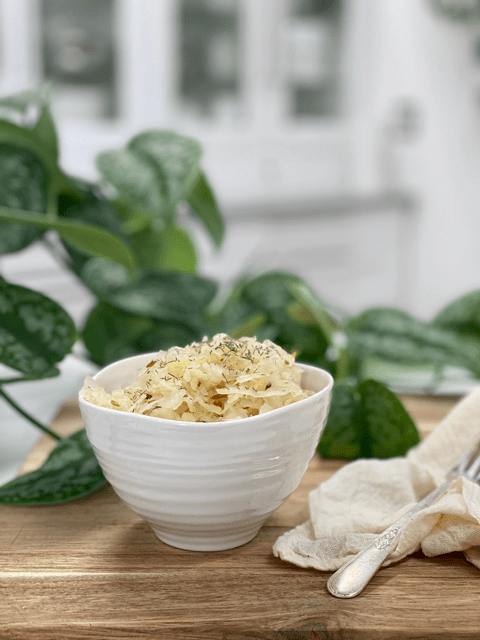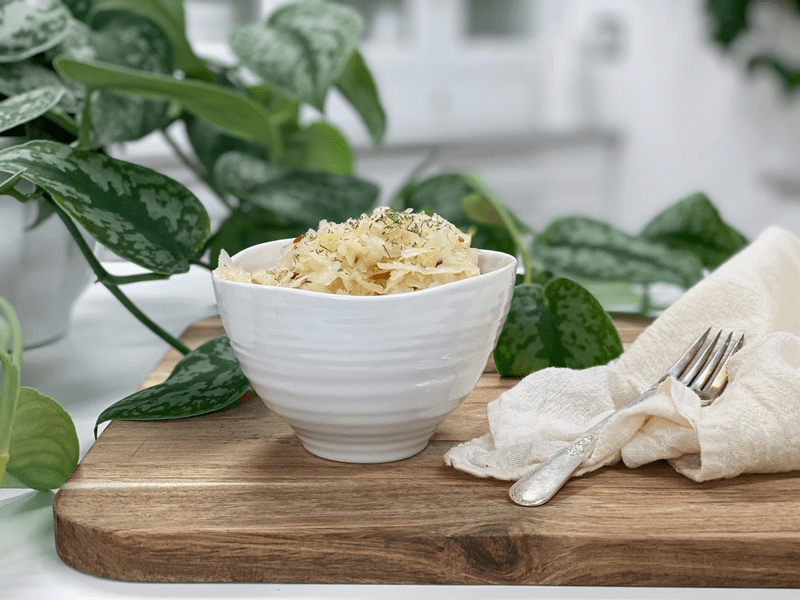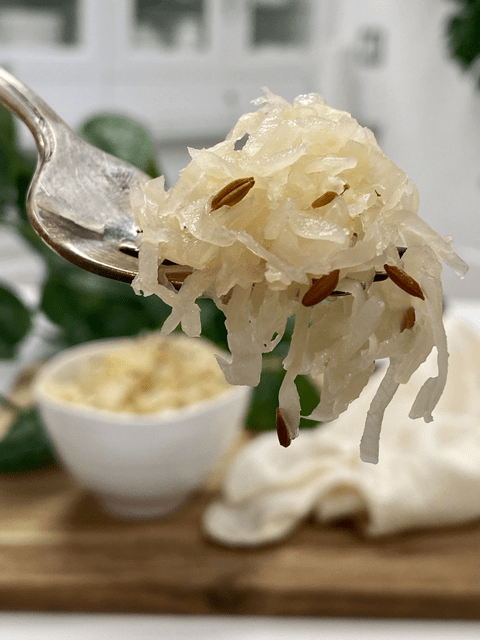


 Add to favorites
Add to favorites
– raw, vegan, gluten-free, nut-free, cultured –
Culturing or fermenting foods is a way of quickly preserving them and at the same time, encouraging the growth of good bacteria (probiotics), which have numerous health benefits. Cultured foods can make a massive difference in the way you digest, the way you feel, and the overall health of your body. If you are new to this whole idea or fermenting and are a bit intimidated… I hope to put your mind at ease. Take a deep breath and give this recipe a try.

Here are the basics so you can get an overall picture in your head. Place a fruit or vegetable that you want to ferment in a jar/container. Add some salt. Side note: there are other “starters” that can be added, but I find salt to be simple and easy. Salt helps to release the water that is inside the cabbage, creating a self-brine.
Salt also acts as a natural anti-microbial, helping to minimize the growth of the ‘bad’ bacteria. Fill the jar to within an inch of the top with water. Then close the jar tightly with an air-lock system and leave out at room temperature for 2-10 days, depending on how strong you want the flavor. Once the process is complete, keep it in the refrigerator.
 I have read that the shelf life is anywhere from 2-12 months, depending on what produce was used. And there you have it, a safely preserved, probiotic-rich, living food to use as a condiment, as a side dish, salt over to add to salsas, dips, smoothies…whatever!
I have read that the shelf life is anywhere from 2-12 months, depending on what produce was used. And there you have it, a safely preserved, probiotic-rich, living food to use as a condiment, as a side dish, salt over to add to salsas, dips, smoothies…whatever!
The main thing to know is that making fermented veggies is NOT an exact science. If you are a serious recipe follower, you might need to let that go, relax, and jump right in! Have fun. The time frame that it takes to ferment/culture can fluctuate depending on room temperature. Every home kitchen varies in warmth so that some batches may ferment quicker than others.
There are many methods for making fermented veggies, and over the years, I have tested a few different methods. My favorite way is using an air-lock system. There are many different ones on the market. You can purchase a complete unit containing a gallon jar, lid, and air-lock system, or you can buy the air-lock tops that will fit any quart-sized jar.
There are even some great DYI sites out there that show you have to make your own lids, step by step if you are handy in the shop. With this device, I never second guess what is going on in my lovely jar of fermenting. For more in-depth reading, I suggest visiting Natural Cultured Health.
These systems provide an air-tight seal, reduces mold on top of ferments, release pressure/gas naturally. They also work with any different size wide-mouth glass mason-type “canning” jar. Another great feature is that your fermented foods can be stored right in the same jar, so you don’t have to transfer it to another container. And most importantly… Simple to use! Wait, I have another “most importantly”…. with the air-tight seals that I listed below, you don’t smell your cabbage fermenting. When I use to make it the old school way, I was always apologizing to visitors for the smell. The Perfect Pickler ~ this system can be used on any wide-mouth jar.
 Ingredients:
Ingredients:
I love your recipes. I can’t wait to try one this weekend!
Thank you Ines… please keep me posted how it goes and if you have any questions along the way, I will do my best to respond quickly to help you. Have a wonderful evening, amie sue
I have been exploring fermenting and you make this seem fairly easy. I will give this a try.
Hi Lynda, if it isn’t easy, I don’t do it. lol Life is complicated enough on its own, no need to make eating food complicated. :) If you have any questions through the process, don’t hesitate to ask. I try to answer quickly. Have a great day, amie sue
I love how you simplify Raw Foods. Your site has kept me believing, that if I want it, It is possible, and like you said, Not that hard. Thanks for making Raw food approachable Amie-Sue.
Thank you Kristina. Often times new ways of preparing foods (no matter what the technique is) can feel overwhelming to people. But when we take a deep breath and find others who can help support you through the process, can really help. :) Have a wonderful day and keep in touch. Blessings, amie sue
Cabbage & caraway make for a great combination. Thanks, Amie-Sue. I’ve been incorporating more fermented foods in my diet. Just made Cabbage Kimchee, so I’ll try your recipe once we’ve finished the kimchee.
They sure do Ben. I have yet to acquire the taste for kimchee but I keep trying it… one day! :) Good to hear from you as always. amie sue
Kimchee seems to get better the more you get used to eating it. If it’s too strong for you, limit or omit the garlic. Just use cabbage, chili pepper and ginger.
Your right Ben… I think the problem in the past was that I had once OD’d on ginger and for years I couldn’t handle the taste of it. But now I am LOVING it again (funny how that happens)… so perhaps I would like Kimchee. Thank you for mentioning this, it has inspired me to give it another go. Have a happy Tuesday. amie sue
sounds great, but way is a air lock system needed? I remember open 5-10 gallon crocks in my Grand parents basement.
There are many ways to make raw sauerkraut Michele. I use to make them with the open top system where you just covered the kraut with large cabbage leaves and put a weight on top. It is all with what people are comfortable with. I prefer this system so I thought I share it. I explained the reasons why in my post. Have a great day, amie sue
At what point do you put the seasoning in the cabbage?
Good day Granny,
It is added right before packing the softened cabbage into jars to ferment. blessings, amie sue